Lander
If you think the Lander looks like something that’s more likely to be found in a NASA hangar than at sea, you wouldn’t be that far off. This instrument was created by Dr. Will Berelson during his PhD work, modified through the years, and is able to withstand extreme environments in an alien world—the deep sea floor. Though there are several US universities with these machines, and a few more active groups in Europe, this USC Lander is, unique, dynamic, yet practical, a bit of a Rube Goldberg device, definitely a one-of-a-kind design.
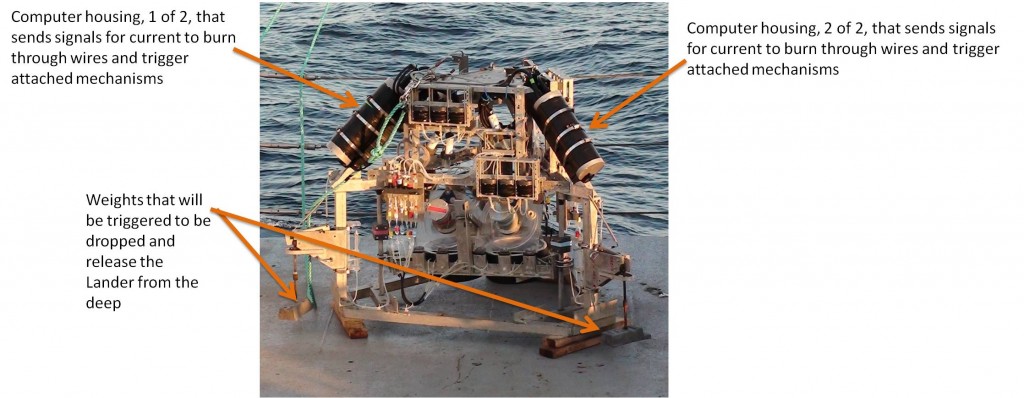 Its purpose is to land on the sea floor and collect a ”time-series” of samples from a self-contained environment. The principle has been explained as basically putting a coffee can upside down on the sea floor. The chamber preserves the water, sediment, and reactions taking place between the two environments beneath it; there is no added oxygen or currents to change the make-up of that system in that moment of time. The scientists can then withdraw samples from the chamber, store them in glass and plastic ampoules and then later analyze to ascertain levels of gases, nutrients, trace-metals, and thus determine any fluxes that may have occurred over the period of chamber ‘incubation’. Incubation time can be hours or days, six sample withdrawals over this period allows for a plot of concentration vs. time to be generated showing what types of exchanges did occur on that section of sea floor, how fast they occurred, and what elements were involved.
Its purpose is to land on the sea floor and collect a ”time-series” of samples from a self-contained environment. The principle has been explained as basically putting a coffee can upside down on the sea floor. The chamber preserves the water, sediment, and reactions taking place between the two environments beneath it; there is no added oxygen or currents to change the make-up of that system in that moment of time. The scientists can then withdraw samples from the chamber, store them in glass and plastic ampoules and then later analyze to ascertain levels of gases, nutrients, trace-metals, and thus determine any fluxes that may have occurred over the period of chamber ‘incubation’. Incubation time can be hours or days, six sample withdrawals over this period allows for a plot of concentration vs. time to be generated showing what types of exchanges did occur on that section of sea floor, how fast they occurred, and what elements were involved.
Once the Lander is deployed, ballasting will force it to sink and eventually reach the seafloor. After a pre-determined time, the computers safely housed inside a thick aluminum pressure case attached to the Lander will emit a signal to send a current through a piece of stainless steel wire attached to a tray that suspends three chambers above the sea floor. Once that line breaks due to being weakened by the accelerated corrosion, the tray with the chambers will fall to the sea floor. The chambers are cylinders, open top and bottom. They partially embed in the mud. Next, the same computer-controlled process will occur, but this time pins holding the chambers lids open will be triggered. Once the lids are closed, the paddles begin turning by means of a magnet. These blades will continue to rotate while the chamber is in place, so the water inside the chamber does not become. A tracer of dissolved Cesium is located in syringes that are wired to inject a known amount of solution into the chamber. This not only tells Dr. Berelson the volume of water in the sample, but also if there were any leaks or issues (i.e. a fish became entrapped in the chamber) based on how much Cesium remains in the samples drawn into the ampoules.
The Lander is capable of taking three samples, one from each chamber, per time period, with a capability of capturing 6 time periods. Samples are drawn by the suction created by a compressed bellow, like a closed accordion, when it opens by spring action. Water sucked out of the chamber passes through two types of sample containers, the first is glass and the second is plastic. The purpose for this is so the first section can collect gaseous samples without it diffusing through the walls of the container. In the second section, the plastic ampoules can hold samples that will be looked at for nutrients and trace metals. As soon as the sample is finished collecting, another timed burn will occur, and a ‘guillotine’ will pinch off the tubes and stop all exchange between the sample ampoules and the chambers. This is a way of preserving the integrity of the samples during Lander recovery.
At the end of the programmed cycles of sampling, the Lander will then be ready for recovery. The Lander has two very different means of deployment and recovery both for deep (>150m) or shallow (<150m) depths. If it is a shallow deployment, a series of buoys and an anchor are deployed with the instrument. The ship must stay within a close radius to ensure no other vessels accidently cross over its lines. If it is a deep water deployment, the Lander is sent down with several glass balls, nicknamed “hard-hats,” on the line but submerged. This type of deployment is called ‘free vehicle’. A pre-programmed release time send programmed into the computer on the Lander to issue current through stainless steel lines holding 3 weights in place. That current again causes the wire to begin to rust and eventually, with the help of the salt water both as a conductor and corrosive, break in two as it has for all the other events. The line breaking releases the levers holding the weights to the Lander simultaneously, and the buoyant glass balls cause the Lander to rise to the surface. For these types of deployments all crew and scientists have a watchful eye on the horizon for the buoys and beacon attached to the Lander, the Captain is also listening for the transmitter’s radio signal.
As soon as the Lander is secure on the deck of the vessel, Dr. Berelson, Dr. McManus, and Nick Rollins (USC technician) close off the ampoules and then transport them to the lab for processing as well as preserving for future analysis. On this trip they are looking at the oxygen and pH of the samples. Further applications could link carbon dioxide levels with their origin, and determine if they are plant or animal based, and even if hydrocarbons (think oil spill) were being respired on the sea floor.
Below you will find a slide show of each of these intricate instruments that make up the entire Lander’s operating and collection systems. Look through the gallery as well for close-ups of each of the instruments discussed above.
- Stainless steel wire after being burned; each time the Lander is recovered all of these lines must be replaced
- When the bellow is released, it rises and sucks in the samples through the attached tubing and into the labeled ampuoles
- When the Lander is deployed in deeper waters (150m+) these floatation units, or “hard hats” are what brings it to the surface when the weights release it from the sea floor
- The three chambers with their lids open; once the time is right and it is on the sea floor, they will close over the chamber and the blade on the lid’s inside will begin spinning
- When the bellows close, the sample from that moment in time is pulled from the chamber into these ampuoles; the first section is made of glass to trap oxygen and other gasses
- The stainless steel wire that is used to trigger all the events during the Lander’s deployment


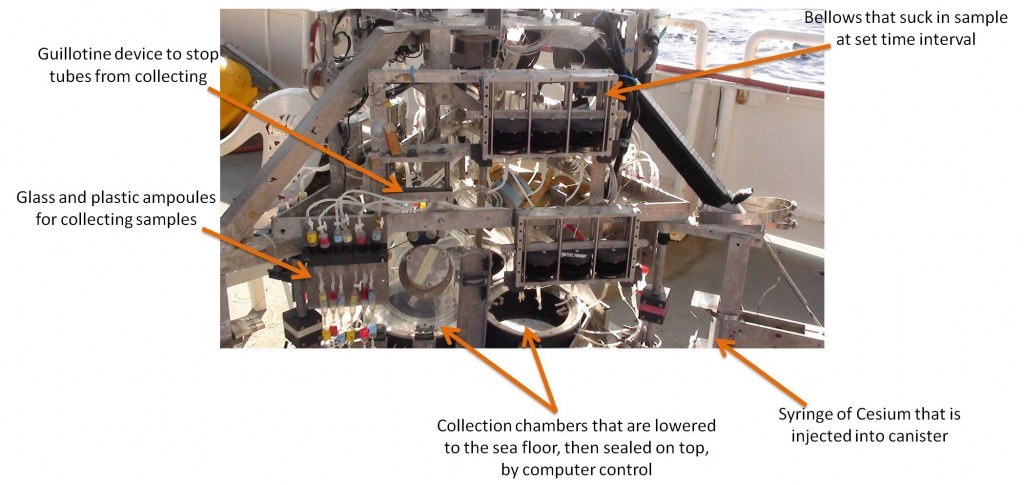
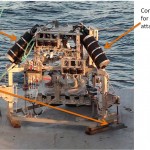
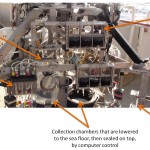
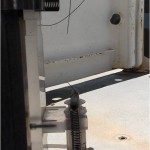
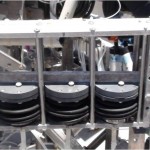
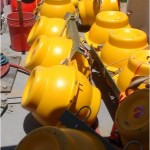
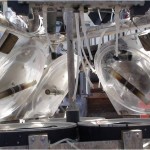
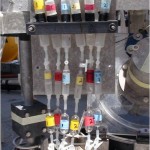
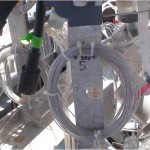
Recent Comments